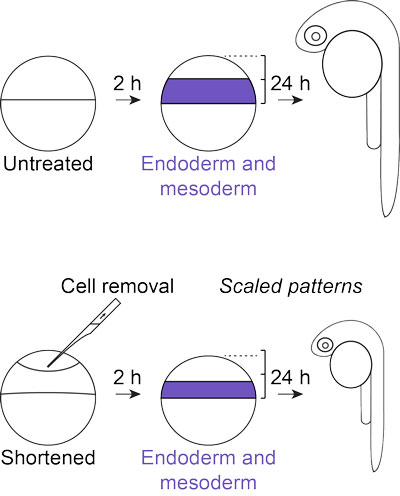In the early 19th century, biologists discovered that removing large chunks of tissue from some embryos surprisingly did not harm the growing creatures – the embryos still developed into smaller but complete and healthy animals. This showed that embryonic development is an adaptive process that can adjust to insults such as dramatic changes in embryo size. Today, we know that embryonic development is controlled by signaling molecules known as “morphogens”. However, how morphogens adapt their activity to different embryo sizes is not fully understood. In a recent study published in Nature Cell Biology, scientists at the Friedrich Miescher Laboratory of the Max Planck Society and at Harvard University used modern methods to revisit the old developmental biological experiments. The support of HFSP was crucial to the development of the project’s interdisciplinary, experimental and computational framework.

Figure: Tissue proportions scale with embryo size. Scaling of the germ layers (e.g. endoderm and mesoderm) is already apparent within 2 hours when zebrafish embryos are shortened by cell removal. The proportions of germ layer derivatives such as eyes also adjust to the new embryo size during the first 24 hours of development.
The researchers focused on the morphogen Nodal and its inhibitor Lefty. These two molecules work together to control the formation of the three germ layers (endoderm, mesoderm, and ectoderm) during embryonic development. The germ layers roughly correspond to the inside, middle, and outside of the embryo, and their establishment is one of the earliest steps in development. The signal for "inside" is given by Nodal: in the areas where Nodal is most active, cells become endoderm, while weaker Nodal activity triggers mesoderm formation. When Nodal activity is absent – for example when it is suppressed by its inhibitor Lefty – ectoderm forms.
If a large chunk of embryonic tissue is removed, the germ layer proportions should be incorrect and development should therefore be disrupted. However, embryos somehow adjust their germ layer proportions and develop just fine. To see whether the Nodal/Lefty activator-inhibitor system can account for this adjustment, the scientists created smaller zebrafish embryos by removing about one third of their cells early in development, mainly from the future ectoderm. Strikingly, they found that both Nodal activity and the germ layers had adjusted within hours to the new, smaller size. This indicated that a change in embryo size could trigger a change in Nodal activity, allowing the proportions of endoderm, mesoderm, and ectoderm to adjust accordingly.
A possible explanation for how the Nodal/Lefty system adjusts to embryo size was revealed by computational analysis. The analysis considered over 400,000 possible versions of the Nodal/Lefty system with different properties like production or diffusion rates. The researchers then screened for versions of the system that could adjust germ layer proportions in response to changes in embryo size. They found that in smaller embryos the concentration of the inhibitor Lefty needs to increase. This in turn reduces Nodal activity, resulting in reduced endoderm and mesoderm formation and correct germ layer proportions.
The researchers experimentally tested this prediction and demonstrated that the model correctly reflected what happens in real embryos, explaining a century-old observation. Their results have also drawn attention to a widespread biological principle: even in single-celled organisms, similar control processes have been described. Mechanisms that rely on the coupling of size to molecule concentrations might therefore be a ubiquitous biological strategy to control growth and development.
Reference
Scale-invariant patterning by size-dependent inhibition of Nodal signalling. Almuedo-Castillo M, Bläßle A, Mörsdorf D, Marcon L, Soh GH, Rogers KW, Schier AF, Müller P. Nature Cell Biology 20:1032-1042 (2018).
Commentary: Shaping up with morphogen gradients
Science Direct: A dilution model for embryonic scaling


































